Few people know that the Psychiatric Survivor Archives of Toronto even exist.
Housed in a small room in the basement of the Gerstein Crisis Centre in downtown Toronto, this archive aims to collect and preserve the stories and histories of people with lived mental-health experience, and to value and dignify some of society’s most marginalized, oppressed and misunderstood people.
The goals of the archive have not changed much since its founding in 1981 by six men who strongly identified as “psychiatric survivors.” The survivors had a DIY philosophy before it became popular—they created a volunteer board of survivors who also acted as volunteer archivists. Later, I became a volunteer archivist there, and part of the psychiatric community.
A note on the historical conditions that made this archive possible: The 1970s saw large changes to the how the mentally ill were treated in the United States. Those who had been institutionalized in large, state-run mental-health hospitals were liberated. America’s left wing saw psychiatric-patient rights as aligned with the emergence of civil rights, gay rights and feminism. Buoyed by the thought of eliminating the enormous cost of running such institutions, the American right wing jumped on board. The movement quickly came to Canada, where some who had been institutionalized their entire lives were suddenly set free to live and fend for themselves. Hence, what has come to be known as the consumer/survivor movement was born.
In the mental health community, the terms “consumer” and “survivor” are often used interchangeably today, but they developed along two distinctive paths. Consumers were more moderate, wanted to work within the system to improve it, fought for a greater say in their treatment, argued for “peer support” from other psych patients, worked on promoting client-centred therapies, sat on boards of hospitals to improve policies, and participated in focus groups to improve psychiatric medications and community-based treatments. Survivors were more radical: they wanted no part of the “system.” Survivors, often diagnosed with schizophrenia or labelled insane, thought of themselves as just that: the survivors of psychiatrists and the psychiatric system. They rejected psychiatric diagnoses, forced treatments, incarcerations, psychiatric drugs and electroshock therapy.
Here is a look at a few of the interesting documents and artifacts that make up the Psychiatric Survivor Archives of Toronto.
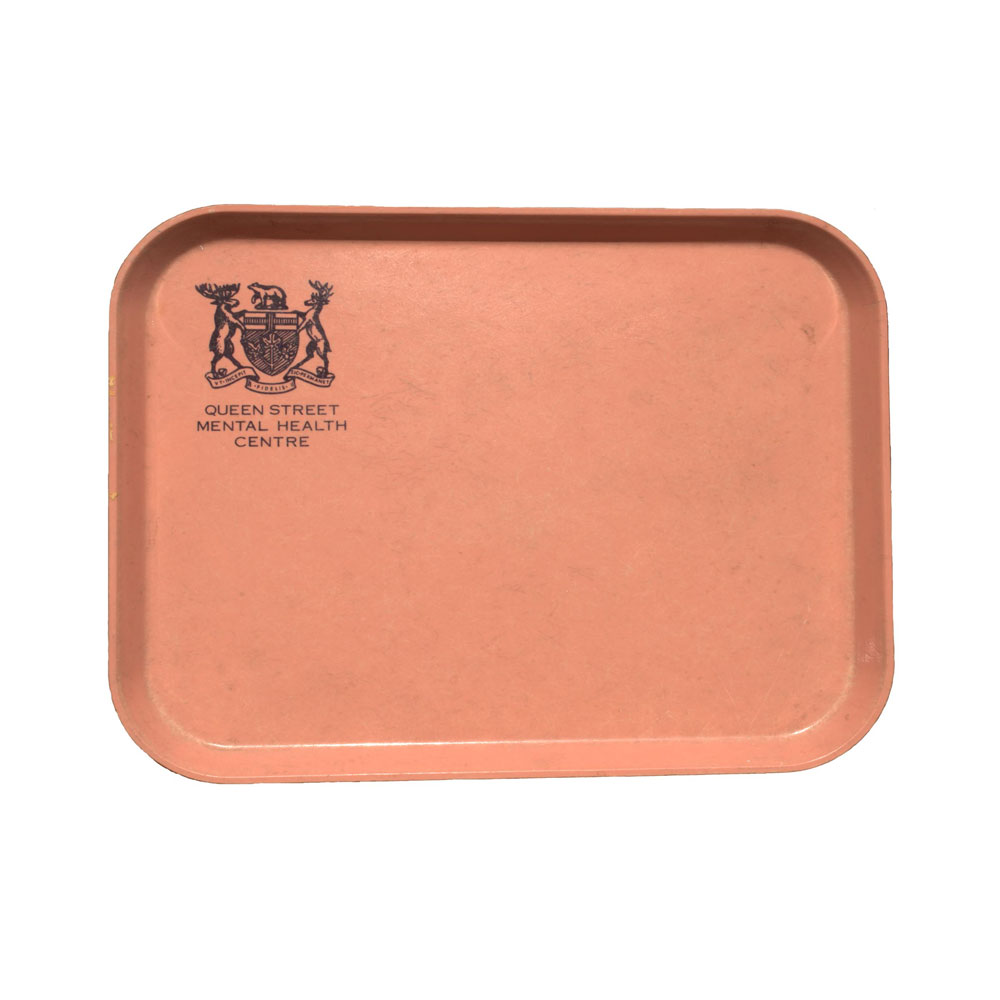 Photo: Robert Anderson.
Photo: Robert Anderson.
1. Plastic Serving Tray from the Queen Street Mental Health Hospital (late 1960s)
Nothing so strongly evokes another time and another place like holding this well-used tray, complete with the identifying logo of an archaic institute, and imagining all those inside the institute who held it and ate off it.
As a link between the modern Centre for Addiction and Mental Health and the 1850-opened Provincial Lunatic Asylum, the tray reminds us of the time from 1966 to 1998 when this facility was called the Queen Street Mental Health Centre.
The stigma from the era of this serving tray is still so strong that the new CAMH changed its infamous Queen Street West address number from 999 to 1001, in an attempt to try and break from the past.
As part of the recent redesign, CAMH officials also wanted to tear down the infamous patient-built wall that surrounded the original asylum, but our archive’s board members rallied to keep one wall standing as a testament to the patients who laboured, without financial compensation, to build the wall, ostensibly further isolating themselves from society.
PSAT co-founder Geoffrey Reaume, now a university professor, was instrumental in the wall-preservation fight, and he has written extensively on the history of the patients who lived their lives behind the wall.
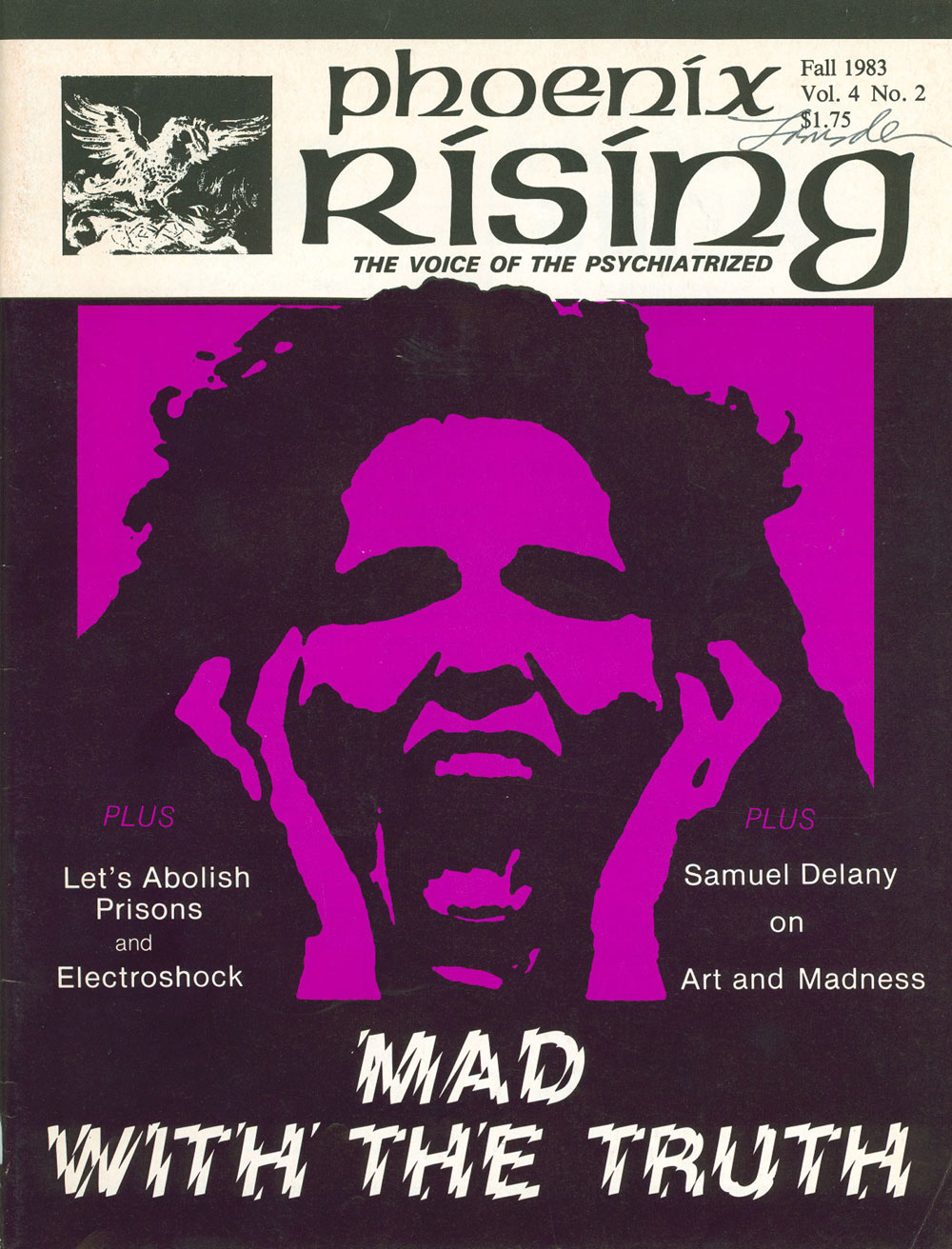
2. Phoenix Rising magazine (1980 to 1990)
The next item of interest is the entire 10-year run of the magazine Phoenix Rising. Co-founded by one of the original PSAT founders, Don Weitz, this magazine brought the movement to the local newsstand.
The subtitle of the magazine says it all: The Voice Of The Psychiatrized. The magazine is a testament to Weitz’s amazing ability to network internationally with seemingly everyone in the survivor movement—and receiving local government funding for a magazine challenging the mental-health system was no small feat.
Whether it was publishing anecdotal stories of ordinary people who felt they’d been victimized by the mental-health system, or critical articles by leading international academics and doctors, Phoenix Rising remains a defining moment in the history of the movement. It brought awareness to mainstream psychiatric abuses, the dangers and potential fatalities of ECT and psychiatric medication, the lack of patient rights around being incarcerated and forced into treatment, the correlation of mental illness and homelessness, and many other important issues that remain relevant today.
Weitz, often flamboyant, always controversial, and still going strong at 85 years old, articulates the vision and remains the conscience of the survivor movement in Canada.
Weitz is an activist, writer, media figure and survivor, but the title he enjoys most is “anti-psychiatry activist.” In the 1950s, he was diagnosed as schizophrenic (though he now rejects all such psychiatric labels) and was forced into psychiatric care, where he almost died when given a major insulin injection and put into a shock-induced coma in hopes of “curing” him.
As well as leading demonstrations and writing books and articles on psychiatric abuses, Weitz has penned letters to editors that have appeared, over the last 35 years, in newspapers such as the Globe and Mail and Washington Post.
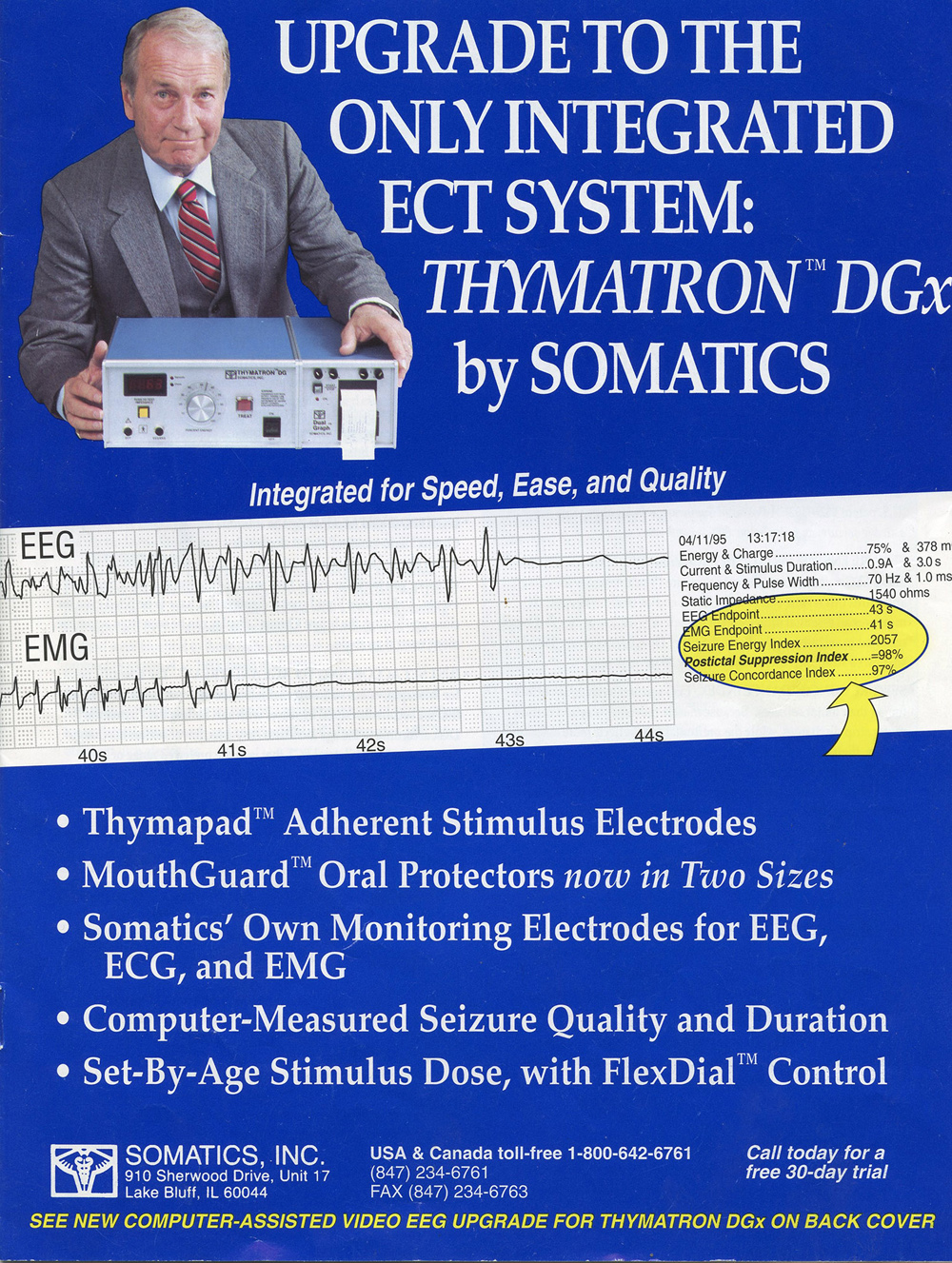
3. Full-Colour Advertising Brochure for an Electroshock Machine (early 1990s)
For many survivors, little evokes the horrors of psychiatric abuse like electroshock. This makes our archival holding of a full-colour brochure and promotional package advertising electroshock machines particularly notable.
Who wouldn’t trust this smiling, elderly man to sell them a new ECT machine? In the early 1990s, two large American companies battled for supremacy in the ECT market: Somatics and Mecta. Like all business rivals, they heavily promoted their products with impressive and costly literature and promotional packages, and even offered time-limited sales on their products.
In the early 90s, a good ECT machine would set you back about $6,000. Don’t forget the mouth guards, as the advertisement says, available “now in two sizes.”
The popularity of the 1975 Academy Award–winning film One Flew Over the Cuckoo’s Nest, and the movie’s depiction of electroshock, strongly turned public sentiment against the controversial procedure. But by the 1990s, ECT had made a comeback. Many people don’t realize that ECT is still being done today in almost every major hospital throughout Canada that has a psychiatric ward.
Don Weitz once used the Freedom of Information Act to obtain statistics on all those who received ECT in the province of Ontario between 1995 and 2001. They showed that a disproportionately large number of women over the age of 65 were represented. And the political and social implications of older women leading the shock-therapy procession seem staggering for our society—a fact activists have pointed out in petitions that proclaimed, “Grandma is getting shocked.”
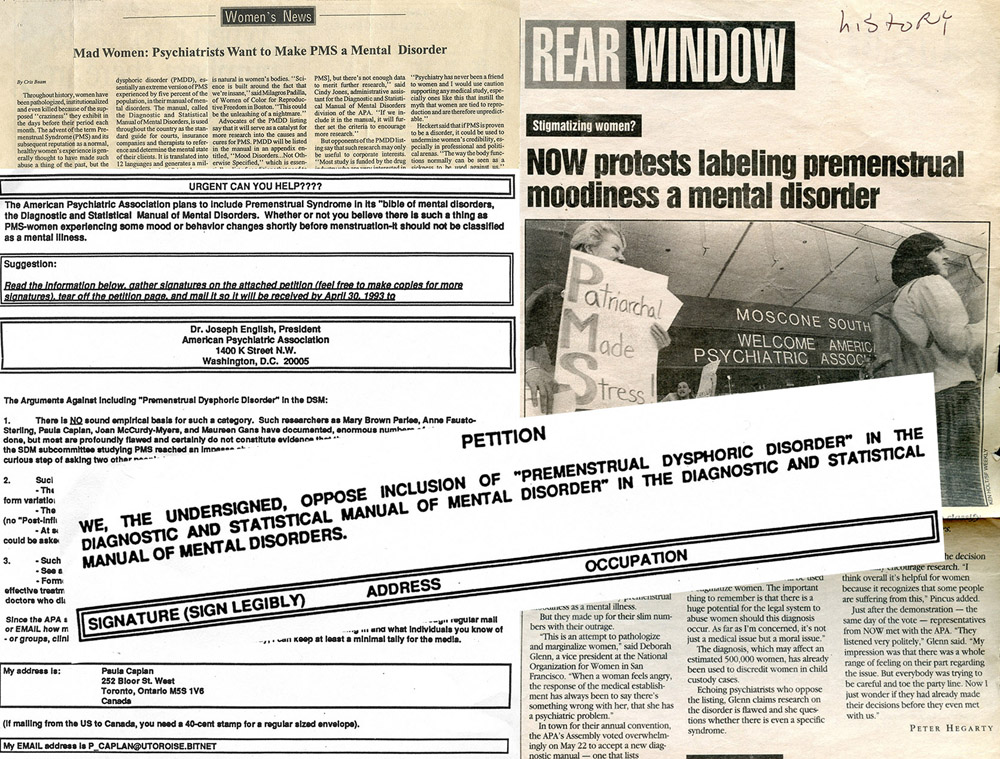
4. Petition Against Adding PMS to the Manual of Mental Disorders (1993)
Many activists feel that women have historically been subjected to sexism by a largely male psychiatric establishment.
This artifact file may further confirm those beliefs. It contains a 1993 petition to protest the American Psychiatric Association’s intent to add pre-menstrual syndrome to the Diagnostic and Statistical Manual of Mental Disorders (DSM). As if our society isn’t pathologized enough, some psychiatrists once wanted PMS to be listed as a mental disorder in the profession’s standard manual.
Political activism, along with maybe a little common sense, kept it out.
Toronto-based clinical psychologist and activist Paula Caplan helped organize this petition and letter-writing campaign. On the petition, Caplan writes, “Thought for the day. Should tampon and sanitary pad packages be marked with the label: WARNING: IF YOU USE THIS PRODUCT, YOU ARE IN DANGER OF BEING LABELED AS PSYCHIATRICALLY DISABLED.”
We’re reminded of the politics of psychiatry here—don’t forget, homosexuality was listed in the DSM until 1973.
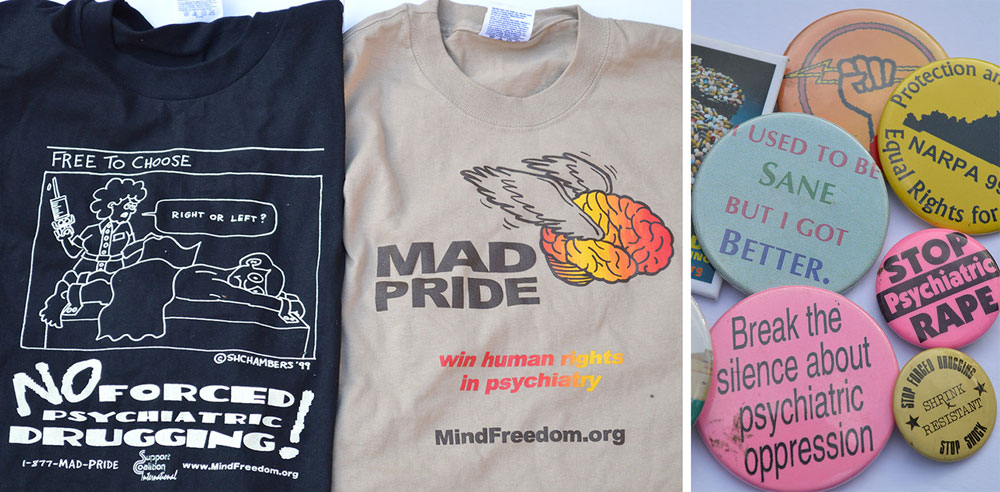
5. Anti-Psychiatry T-shirts and Buttons (1990s)
If you really want to stand out in the mental-health crowd, you won’t want to be without these items: anti-psychiatry T-shirts and buttons. They say it pays to advertise, and these ’90s-era items never seem to go out of fashion.
All the items depicted here were distributed by Mindfreedom, founded by iconic American survivor-movement leader David Oakes. Oakes is to the American survivor movement as Don Weitz is to the Canadian one.
It may not be very artistically pleasing, but the drawing of a brain with wings attached to it represents Mindfreedom as logo. It was a major coup for PSAT that in the mid-’90s Oakes shipped his large Mindfreedom archives from their home in Oregon. It also demonstrates the uniqueness of PSAT, and lack of other such similar archives in the United States.
Many of the most interesting items of PSAT come from this large international Mindfreedom collection—fascinating court documents of psychiatric survivors or their loved ones going up against the mental-health establishment, all the way to the US Supreme Court, can be found here.

6. Documents and Photographs from the Tragic Case of Albert Levy (late 1990s)
One of the long, winding cases collected in the Mindfreedom fonds described above is the tragic life of Albert Levy.
A press release tells the story of the teenaged Levy being taken to a psychiatric hospital and treatment centre in New York. There, he received “toxic levels and combinations of Lithium, Depakene and Zyprexa.”
The press release further notes, “This treatment was administered with the depraved indifference of his treating psychiatrists. Albert now lives in a semi-vegetative state receiving round-the-clock care for all needs, including basic bodily functions, by family members and home-healthcare service workers.”
Levy’s mother brought a lawsuit, and included in these files are the official doctor’s assessments of Levy provided for the courts, as well as comprehensive diagnostic and psychological evaluations, itemized costs of “treatment” from one psychiatric treatment centre (paid by Levy’s mother), various discharge summaries by attending doctors, legal affidavits and independent medical analyses of the case that condemn the psychotropic medications as prescribed.
The most disturbing letter of the Albert Levy saga came from his mother, when she reached out to Mindfreedom’s David Oakes for the first time in September 2000. Resigned to the hopelessness of her son’s future, Levy’s mother concludes, “There is nothing more imperative to me on this planet than to dedicate myself for the rest of my life to rescuing and restoring dignity to as many of these suffering victims as I possibly can.”
Regrettably, there are many more such tragic stories.
 Photo: Robert Anderson.
Photo: Robert Anderson.
7. Audio Tape Referencing the Death of Wayne Williams (June 14, 1997)
Radio host: “Last June, police shot and killed 24-year-old Wayne Williams, a young black man who refused a police order to drop a knife…Are the Toronto police targeting psychiatric survivors, as well as the homeless and young black youth?”
Is this another media report discussing the recent death of a black man on the streets of Toronto, a news item another Black Lives Matter indictment of systemic racism on the police force?
No.
This is from a radio broadcast on June 14, 1997, recorded on a cassette tape labelled Police Violence – Psych. Survivor. It’s one of well over 400 audio tapes made by Don Weitz, which now reside at the Psychiatric Survivor Archives of Toronto.
Though Canadians in 2016 may know the names Andrew Loku and Abdirahman Abdi—men of colour with mental-health issues who died at the hands of police in Ontario in recent years—the audio tapes in Weitz’s collection, which document protests and conversations as well as radio shows, remind us that such incidents have been repeated for decades.
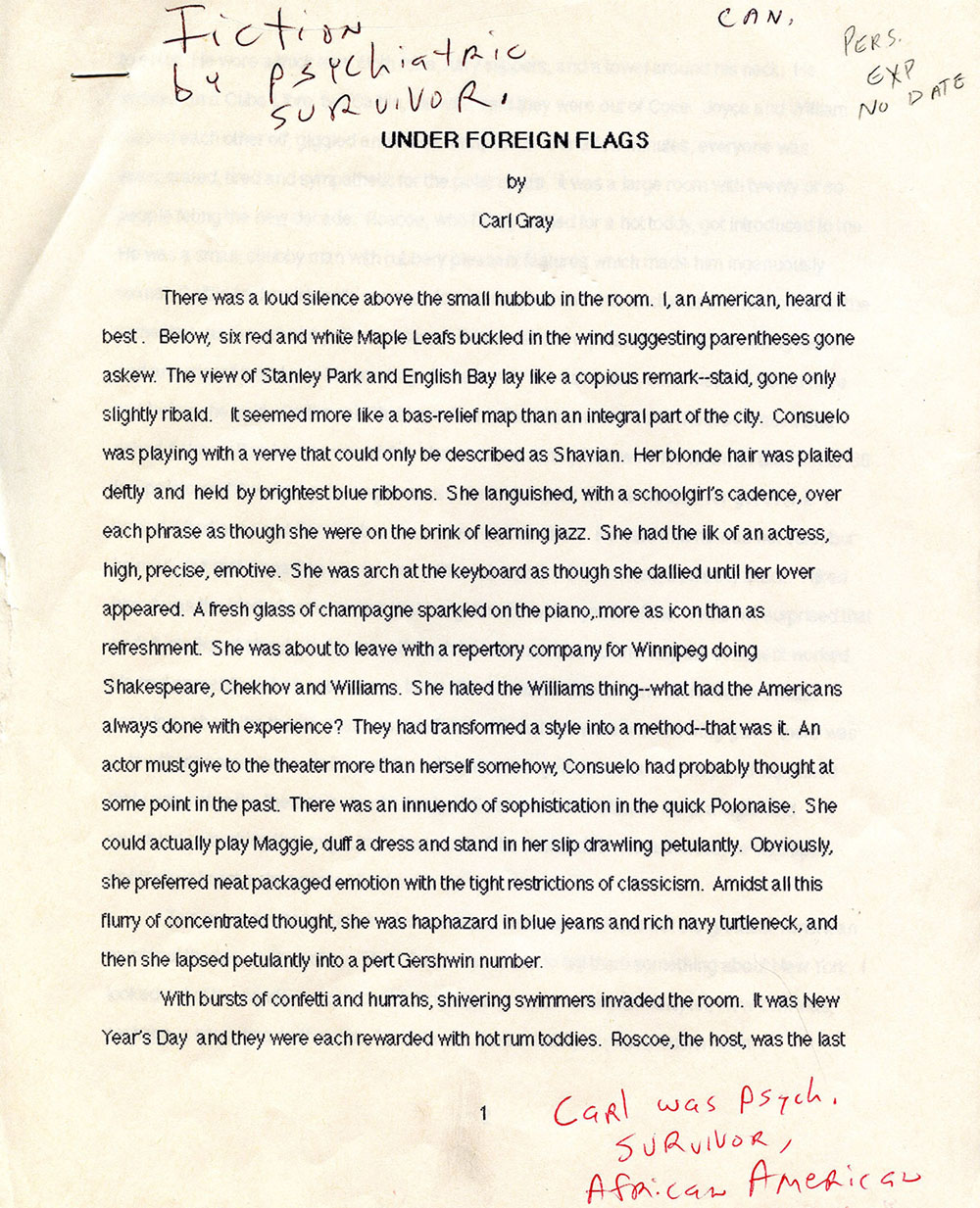
8. Under Foreign Flags Manuscript (date uncertain)
The holdings of PSAT are not always as disturbing as one may think. Sometimes, they give voice to in-depth first-person accounts that span experiences that are both pleasant and unpleasant.
We’re all familiar with mainstream views expressed in the media. It’s the voice of the outcast or marginalized that we rarely hear.
First-person narratives outside this media stream are the foundation of PSAT. If someone can write his or her life story in an elegant and compelling narrative, then so much the better.
No story in our archives is better written than that called Under Foreign Flags. This is a typewritten, unpublished manuscript. I’ve been unable to find any more details about the writer. The only details I know of the man is what he has written in this compelling autobiographical document.
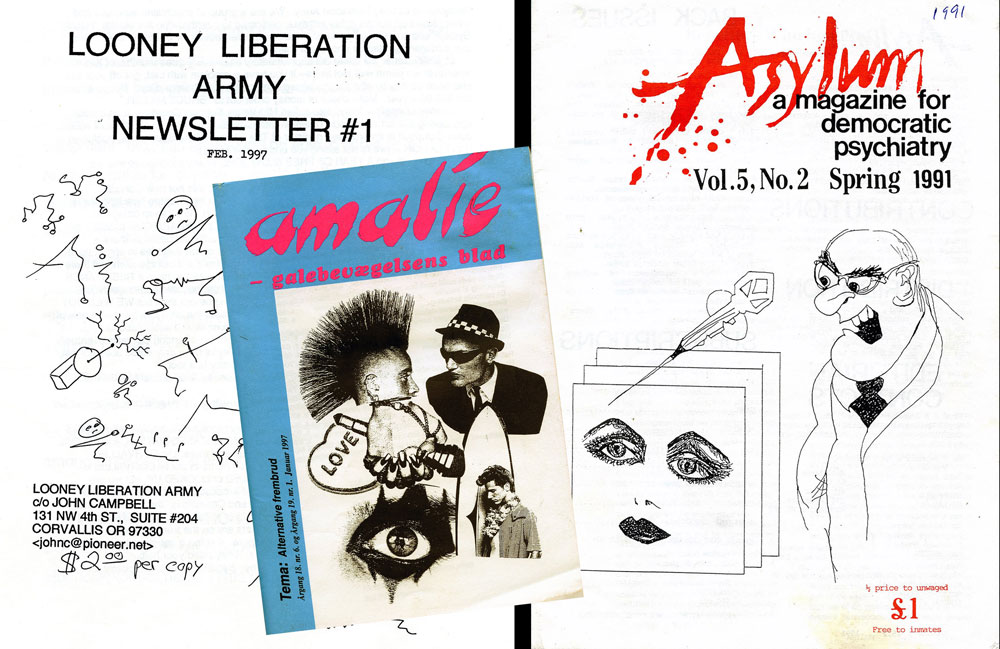
9. International Survivor-Movement Magazines (1980s and 1990s)
You won’t be finding many of these magazines in your local library anytime soon.
These are some of the international magazines and zines, often photocopied by hand, that contain articles by members of various psychiatric communities around the world.
Such magazines offer support and networking opportunities for like-minded individuals, and are uncensored and often fun to read. Serious articles in these publications are often more like rants.
Pictured are three such international journals, or zines: Looney Liberation Army Newsletter (1997, Oregon), Asylum: a magazine for democratic psychiatry (this issue 1991, Sheffield, England) and Amalie: Mad Movement Magazine (I’ve translated the title of this Denmark publication. PSAT carries the entire run from 1980 to 1990). There’s lots of fun graphics and illustrations in Amalie. Notice on the bottom right corner of Asylum it says in small letters, “free to inmates.”

10. Psychiatry for the Home & Garden / Also in Restaurants & Public Places by Helen Ludwig (1970)
The hallmark activity of being in a psychiatric ward or being a longtime consumer/survivor is doing art and poetry. One of the most recent researchers to visit PSAT was a graduate student from BC who was doing his thesis on survivor poetry and expressive writings, and he was happy to find one in the collection from 1960. Indeed, survivor poetry has gained respect as a genre of academic study in mental-health discourse, if not in literary discourse. These self-published books are plentiful at PSAT.
Here’s one such book in the collection combining the best of art and witty writing by a psychiatric survivor: Psychiatry for the Home & Garden / Also in Restaurants & Public Places.
Helen Ludwig self-published this novel-sized work in November 1970. She was a San Francisco resident, and a little biographical note in the back says she studied art at Hartford Art School, which explains the good quality of her ink drawings.
Presumably, Ludwig’s experience as a survivor informs her sense of humour throughout the book. On the inside cover, Ludwig explains in large, red-ink lettering: “Your subconscious makes a good burial ground. Don’t excavate!”
The dedication inside the book may also resonate with many: “Dedicated in a playful spirit to our head shrinkers, some of whom I’m sure have helped some of the people some of the time.” Hey, psychiatric humour can be fun.
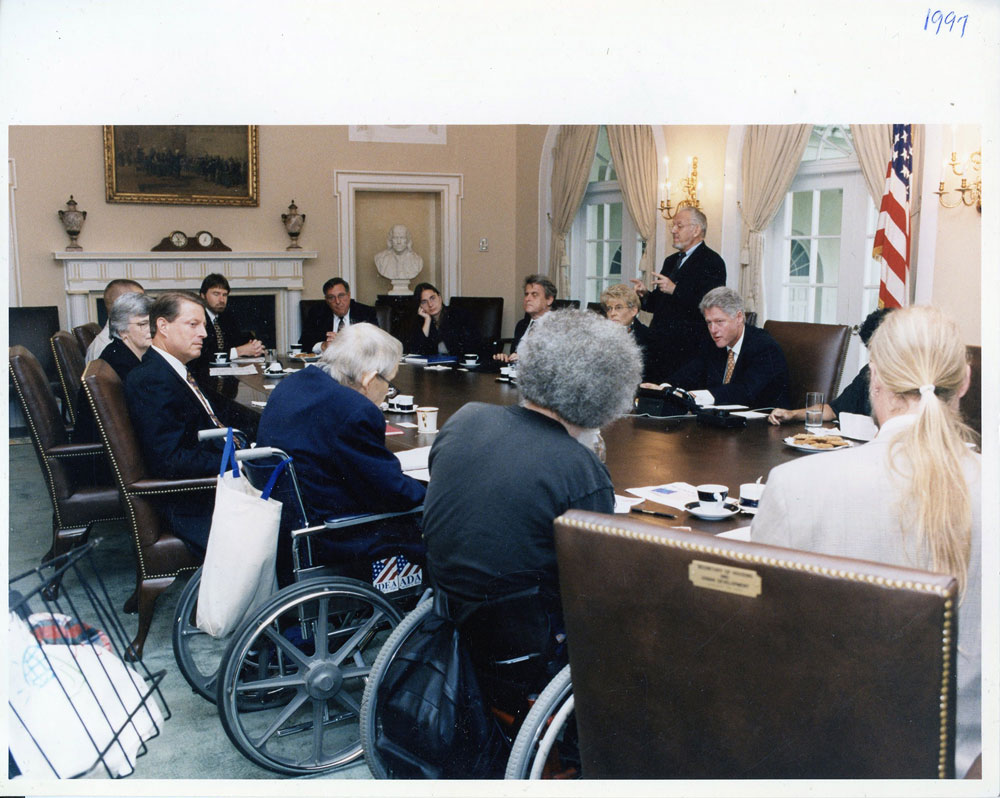
11. Photograph of Disability Movement Activists with President Bill Clinton and Vice-President Al Gore (1997)
The consumer/survivor movement has become part of a new discourse on critical disabilities—one that has, in some ways, reached the government from time to time, as evidenced by this, an official 8-by-10-inch White House photograph from 1997, where disability activists meet with President Bill Clinton and Vice-President Al Gore.
Further to this discourse, the question of what a disability is is now being more widely questioned. University programs in Canada and the US now have programs that study the experiences of disability (including mental-health disabilities) from a critical perspective. Academic journals, like the Canadian Journal of Disability Studies and Critical Disability Discourses, have arisen to support the cause and give credibility to new ideas. Key topics include anti-oppression and social justice. Many PhD graduates of critical disability studies don’t believe in the DSM, often thought of as the bible of psychiatric labels, nor do they support the biomedical beliefs of doctors who believe schizophrenia is a disease of brain, or if such a thing as schizophrenia really exists.
For instance, in treating depression, the longstanding theory of a chemical imbalance in the brain has largely been invalidated by some scientists. This raises the question of why anti-depression pills, created to “correct” this “chemical imbalance,” are still widely prescribed and still manufactured by the billion-dollar pharmaceutical industry. Maybe Don Weitz wasn’t so radical after all.
With long-time psychiatric survivor and activist Pat Capponi being awarded the Order of Canada last year, it can be hoped that more recognition will be coming to the cause. The Psychiatric Survivor Archives of Toronto, like the consumer/survivor movement itself, continues to change and evolve. With a totally new board of directors, still with lived experience of the mental-health system but with a decidedly less radical view, PSAT continues to represent a resilient group of people whose lives are part of a journey: one worth knowing and preserving.
Robert Anderson is a visual artist and poet. He recently worked as a researcher for Sound Times Support Services. Last year, award-winning publisher Bookthug published his chapbook, The Hospital Poems, a copy of which can be found in the Psychiatric Survivor Archives of Toronto.

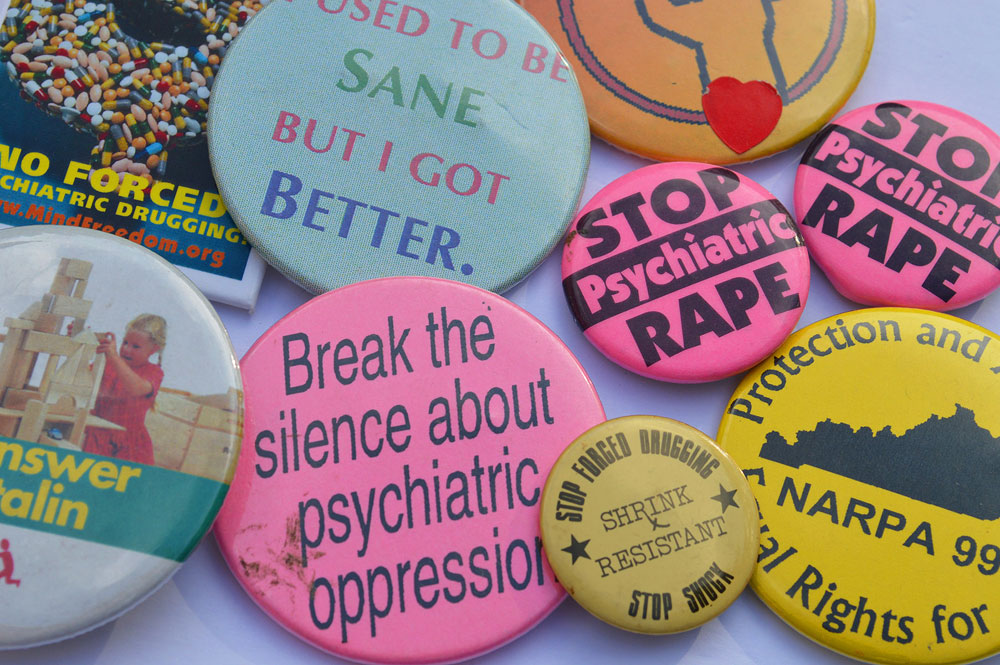 An array of buttons found in the files of the Psychiatric Survivor Archives of Toronto. Photo: Robert Anderson.
An array of buttons found in the files of the Psychiatric Survivor Archives of Toronto. Photo: Robert Anderson.







